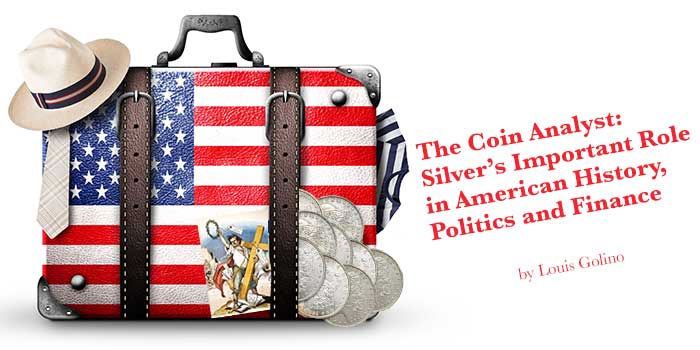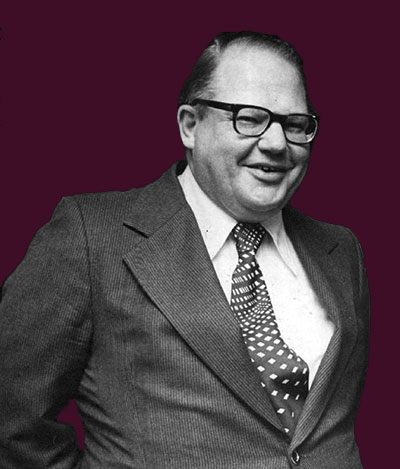
By Louis Golino for CoinWeek …..
If you’re reading this article, then you likely have more than a passing interest in silver.
But while you may be familiar with the role the white metal has played in our coinage for thousands of years, you probably do not know the entire story of how the metal has impacted the American political and economic system since the nation’s founding. Not to mention silver’s role as a siren that has tempted and obsessed some of the richest people in history like Warren Buffet and, most notably, Nelson Bunker Hunt and his brother Herbert: the infamous billionaire Hunt brothers.
It was primarily due to the author’s interest in the fascinating story of how the Hunt brothers cornered the market in silver in the late 1970s, driving its price up to $50 an ounce by January 1, 1980 (which was also due to world events such as the Iranian Revolution) that finance expert William Silber wrote his deeply researched and beautifully written The Story of Silver: How the White Metal Shaped America and the Modern World.
Silber was, for 30 years, a finance and economics professor at New York University’s Stern School of Business. He has served as a consultant to many companies, as well as the President’s Council of Economic Advisers, and is the author of many previous volumes. His well-received new book published earlier this year helps educate the reader about many of the key concepts regarding silver’s role in the U.S. monetary system while also providing an entertaining account of the key personalities that have shaped that history. Some reviewers have compared it to a John Grisham thriller.
 Even without studying the extensive footnotes, the reader will learn about matters such as Gresham’s Law—i.e., “bad money drives good money out of circulation (page 13)” –meaning that when the intrinsic value of coinage exceeds its monetized value, people will hoard it. That is why setting the right ratio between silver and gold is critical when they serve as the basis of money in order to avoid over- or undervaluing each metal and creating circulating currency imbalances.
Even without studying the extensive footnotes, the reader will learn about matters such as Gresham’s Law—i.e., “bad money drives good money out of circulation (page 13)” –meaning that when the intrinsic value of coinage exceeds its monetized value, people will hoard it. That is why setting the right ratio between silver and gold is critical when they serve as the basis of money in order to avoid over- or undervaluing each metal and creating circulating currency imbalances.
Silber’s focus is on how silver went from soft money to hard asset and how powerful individuals — either acting on their own behalf or for the silver industry — have manipulated silver’s role in our monetary system and its price. Many readers probably have heard about how the mining industry lobbied for passage of legislation that resulted in the striking of the Morgan dollar from 1878 to 1904 and in its return in 1921 following extensive melting. But many may not realize how fundamental this dynamic has been to the role of silver in our monetary system and may not be familiar with the repeated cycles of unintended consequences from domestic support for the silver industry on our economy and even on our foreign policy and major world events.
The author, who has traded precious metals on the COMEX, does not seek to make a case for investing in silver per se but does note how it has historically served as the preferred hedge against inflation and political turmoil. He also suggests it can play a role as a storehouse of value in your portfolio as a more affordable hedge against uncertainty than gold, as well as a more volatile one. In addition, he suggests that it’s unlikely we will see a return to a silver-based currency but doesn’t rule it out completely, either.
The Hunt Brothers
Nelson Bunker Hunt became the richest man in the world at age 40 in the 1960s after oil was discovered in Libya. Hunt sought to protect himself against rising inflation in the U.S. (caused not only by rising oil prices in the 1970s but also, as Silber helpfully explains, by the creation of fiat currency) by accumulating large amounts of silver.

By 1968, Congress had ended the use of silver in circulating coinage by stopping production of Kennedy half dollars with 40% silver content (after ending the production of 90% dimes, quarters and halves in 1964). Then in 1971 President Nixon ended the convertibility of dollars held by central banks into gold (the “Nixon Shock“), which created currencies with no intrinsic worth, or fiat currencies. That enabled the Federal Reserve to create credit in response to political pressure, which eventually led to double-digit inflation. The Hunts kept buying silver until they had 200 million ounces, which by 1979 was worth $10 billion. But because they became obsessed with silver and bought it on credit, when the price declined sharply after it peaked in early 1980, Nelson’s action precipitated a financial crisis, and he went bankrupt.
Silber (whose last name serendipitously means “silver” in German) goes back to the founding of the American nation to understand silver’s role. Alexander Hamilton, the first Secretary of the Treasury, favored a bimetal monetary system based on silver and gold coinage, which led to the ratio of 15 to 1 between the two metals established under the 1792 Coinage Act used for many years afterward.
Republican Senator John Sherman of Ohio, who became Chairman of the Senate Finance Committee and later served in several cabinet positions, promoted legislation that ended the production of silver dollars in 1873 while also establishing gold as the sole form of legal tender in what became known as the “Crime of 1873”. As Silber explains, Sherman used confusing legislative language to convince his congressional colleagues to support the bill. This happened at a time when new discoveries of gold were being made not only in the Western states of the U.S. but also in Australia and Russia, vastly increasing the amount of gold in a short period.
It also happened as many European countries were selling massive amounts of silver and decreasing the production of silver coinage as they switched to gold. All these actions led silver to lose half its value.
The Return of Silver
A powerful silver bloc later emerged in the United States Senate that consisted of 14 senators who represented western mining interests, led by Nevada senator Key Pittman, who became chairman of the Senate Foreign Relations Committee. Newly elected President Franklin D. Roosevelt, who needed senate support for his New Deal initiative, agreed to support the Silver Purchase Act of 1934, which reestablished the role of silver in our monetary system with a buying program designed to make the metal 25% of U.S. monetary reserves.
But subsequent large silver purchases and the rise in its value had the unintended consequence of driving China off the silver standard and eventually contributed to the economic strengthening of Japan and Sino-Japanese conflict in the run-up to World War II. And rising inflation in China helped lead to the Communist victory in 1949. It would be easy to argue that those effects were strongly against American interests and that they underscore the dangers of domestic support for specific sectors of the American economy.
Another key account in the book concerns President John F. Kennedy, who repealed FDR’s silver purchase legislation in June 1963 in an effort to demonetize silver and who, according to the author, “had long favored eliminating any monetary use of the white metal (page XIX).”
He then adds a curious hypothetical regarding whether the Warren Commission should have looked into whether JFK was murdered for dropping the silver subsidy, which he calls “a conspiracy no worse than the rest given the metal’s power to provoke passion and fury in the American heartland for more than a century (XIX).”
As the author explained in a May 9 interview about the book, in the early 1960s when the U.S. was still producing 90% silver coinage, the demand for it began to outstrip supply with the mining of new silver running 100 million ounces behind the amount then being used by the world. It is hardly surprising that as silver was becoming scarcer and increasing in value, circulating coinage began to exceed its face value, leading to coin shortages and hoarding and to coin collectors becoming speculators. JFK and his successor President Lyndon Johnson first limited and then in 1964 ended the use of silver in our coinage.
Silber ends his book by noting that “central bank independence throughout the world has replaced gold and silver as guardian of the currency (251)” and that Congress could with a simple majority vote to abolish the Federal Reserve, which could unleash a printing press for dollars and a huge increase in inflation. He has written an important and unique book about the intersection of silver with American history and world events. But the suggestion that JFK may have been murdered for ending the silver subsidy seems far-fetched.
In addition, the book could have used more discussion about the role of silver in Asia, where since the 16th-century silver coins have helped facilitate international trade and the first globalization of the world economy.
* * *
 Louis Golino is an award-winning numismatic journalist and writer, specializing primarily in modern U.S. and world coins. His work has appeared in CoinWeek since 2011. He also currently writes regular features for Coin World, The Numismatist, and CoinUpdate.com, and has been published in Numismatic News, COINage, and FUNTopics, among other coin publications. He has also been widely published on international political, military, and economic issues.
Louis Golino is an award-winning numismatic journalist and writer, specializing primarily in modern U.S. and world coins. His work has appeared in CoinWeek since 2011. He also currently writes regular features for Coin World, The Numismatist, and CoinUpdate.com, and has been published in Numismatic News, COINage, and FUNTopics, among other coin publications. He has also been widely published on international political, military, and economic issues.
In 2015, his CoinWeek.com column “The Coin Analyst” received an award from the Numismatic Literary Guild (NLG) for Best Website Column. In 2017, he received an NLG award for Best Article in a Non-Numismatic Publication with his piece, “Liberty Centennial Designs”.
In October 2018, he received a literary award from the Pennsylvania Association of Numismatists (PAN) for his 2017 article, “Lady Liberty: America’s Enduring Numismatic Motif” that appeared in The Clarion.




